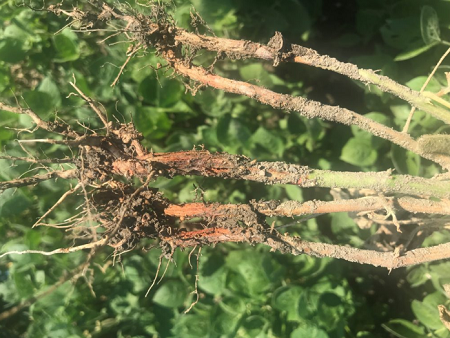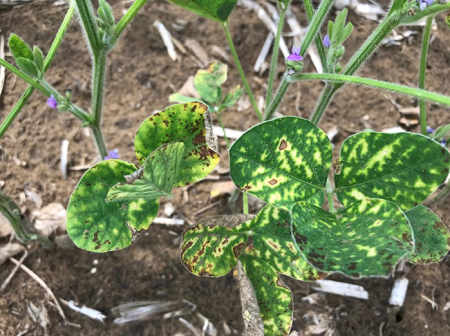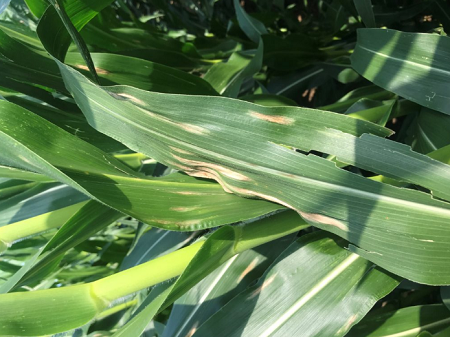Winter Wheat
Winter wheat harvest is winding down across the province and reported yields to date have ranged from 80-130 bu/ac which compares well to the five-year average yield of 82.7 bushels/ac. This was a pleasant surprise for many growers’ considering all the stresses the winter wheat crop had to endure. Good reports of straw yield averaging 4000 pounds per acre, which above the average 3000 lbs per acre. Wheat quality has been high with very low levels of Fusarium head blight (FHB) which is a testament to the progress which has been made to deal with FHB by increased availability of improved tolerant varieties, disease forecasting, more efficacy fungicides and better timing of these products, etc. Reducing producer risk and economic losses to FHB requires the integration of available cultural and management “tools” or practices into a sustainable program, so keep up the good work as you plan for 2020.
Soybeans
For soybeans, those areas of the province such as the southwest which have had frequent rain events, the soybean crop in most cases looks good and is advancing rapidly. Some yellowing due to water ponding (2+ inches) on the clay soils in Chatham-Kent and Essex are evident. Soybean fields located in dry areas are showing early signs of reduced pod fill, flower abortion, reduced growth which may impact yields. Diseases especially sudden death syndrome, Rhizoctonia (see Figure 1.) and Phytopthora root rots and soybean cyst nematode are apparent in many fields.

Sudden death syndrome (SDS) developed early this year in the southwest and symptoms have increased the past few weeks due to the crop stage (post flowering) and weather conditions. The SDS fungus produces toxins in soybean roots that are transported to leaves and foliar symptoms are more severe after frequent or heavy midseason rains. SDS infected plants will begin to show distinct yellow speckling or spotting between the veins (interveinal chlorosis) see (Figure 2.). As the disease progresses, these yellow areas become larger and in severe cases the entire area between the veins becomes brown (necrotic) and dry. The leaves curl from the outer margin. These brown areas eventually disintegrate (fall out) leaving only the veins on the leaf. All through this process the veins remain green. The next symptom is often premature defoliation and death of the plant. In most cases, the petioles (leaf stalks) on these dead plants remain attached to the stem.

Cutting the root and the stem will expose a light brown or gray discolourization of the cortex tissue in the tap root and the stem. This discolourization will extend from the roots up through the stem. Although the leaf symptoms may resemble brown stem rot, in sudden death infected plants the pith (centre) of the stem remains white whereas brown stem rot infected plants have a brown and disintegrated pith.
Corn
Corn particularly in Eastern and Central Ontario are showing typical moisture stress symptoms while in field plant variability was obvious during tasseling which made fungicide application timing very difficult. Western bean cutworm levels have been low and egg masses have been rare which has allowed many growers to skip insecticide applications. Reports of good natural enemy populations have likely helped alleviate pressure. Corn varieties that were switched late spring, and were not resistant to rootworm, are being monitored on second- and third-year corn rotations. Overall foliar disease pressure has been low across the province, but northern corn leaf blight has increased in areas with frequent rains see (Figure 3.). Historically, those years where the corn crop was planted late, foliar diseases as well as stalk rots have increased later in the season. The frequent rains, high humidity and foggy mornings in areas of southwestern Ontario are potentially favourable for Gibberella ear rot infection however, it is important to remember hybrid, management and the weather conditions through grain fill in critical to subsequent mould growth and DON accumulation.

The 2019 growing season has been challenging no doubt, but it is important to continue to scout fields. Make note of which diseases, insects or other problems are present and to what degree. Remember every field is different and therefore get in the habitat of doing this for each field. This information in conjunction with harvest data will help you in selecting the appropriate hybrids and varieties geared to your specific needs as well as implement the appropriate management strategies for 2020 and beyond.
Crop Protection Network
The Crop Protection Network (CPN) is an additional helpful source of information to help you plan for 2020. CPN publications provide research-based information on field crop diseases and agronomic issues and CPN is pleased to announce this addition to its collection of resources available to farmers, crop advisors and others involved in crop management and production. Certified Crop Advisors (CCAs) will have the opportunity to obtain continuing education units (CEUs) under the Integrated Pest Management (IPM) category, through CPN in the form of educational quizzes. A total of 19 quizzes are currently available through the website (www.cropprotectionnetwork.com) and are each based on CPN publications covering areas such as: disease management, pest resistance and mycotoxins. After reading CPN publications, CCAs can take the corresponding quiz for 0.5 CEUs, simply by entering their names and CCA number, and starting the exam. Participants must earn a passing score of 70 percent or more on a quiz to qualify for credits. OMAFRA’s involvement in CPN has been partially supported by the Grain Farmers of Ontario.
Source : Field Crop News